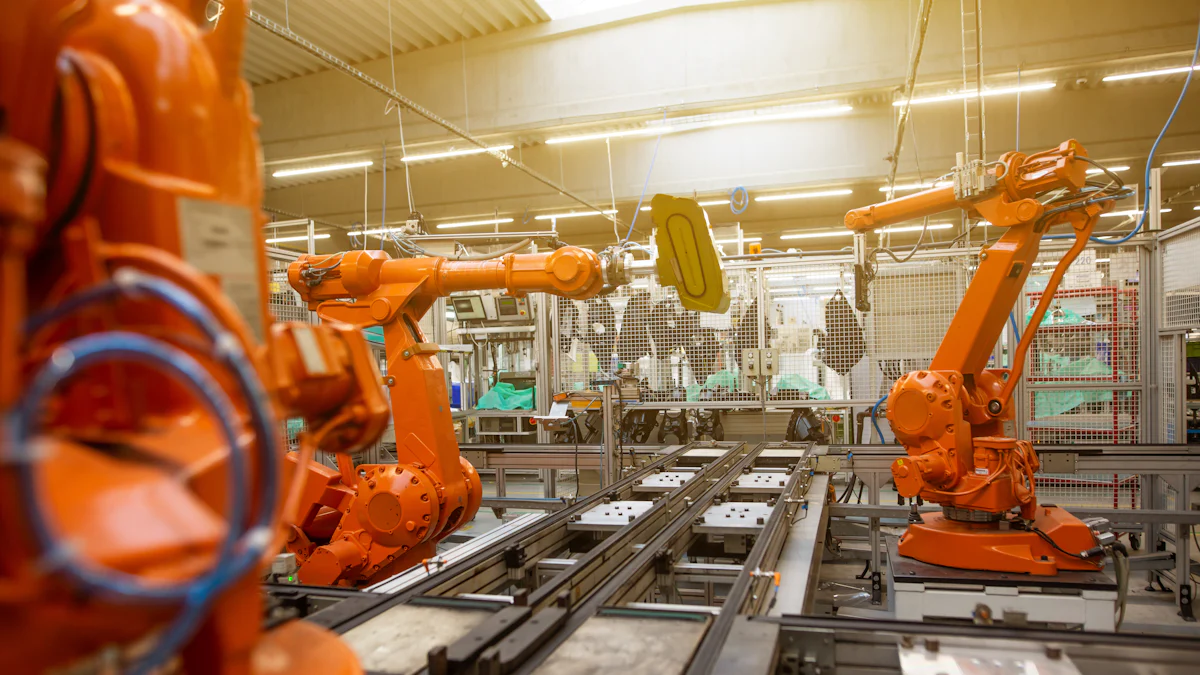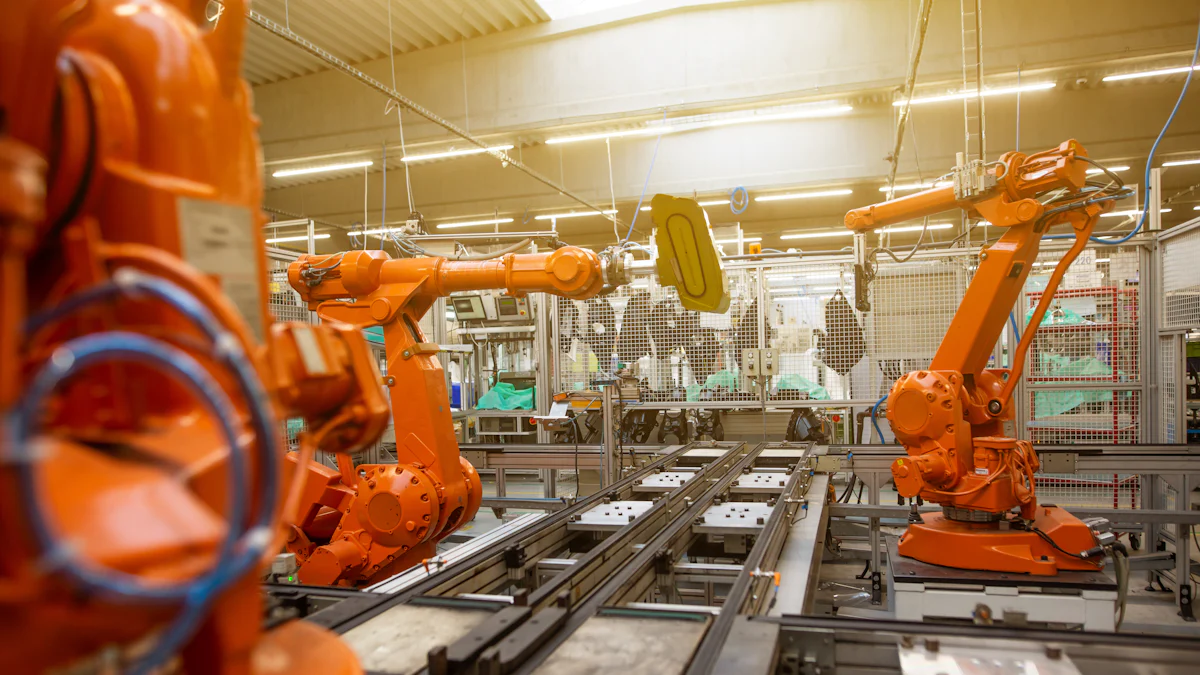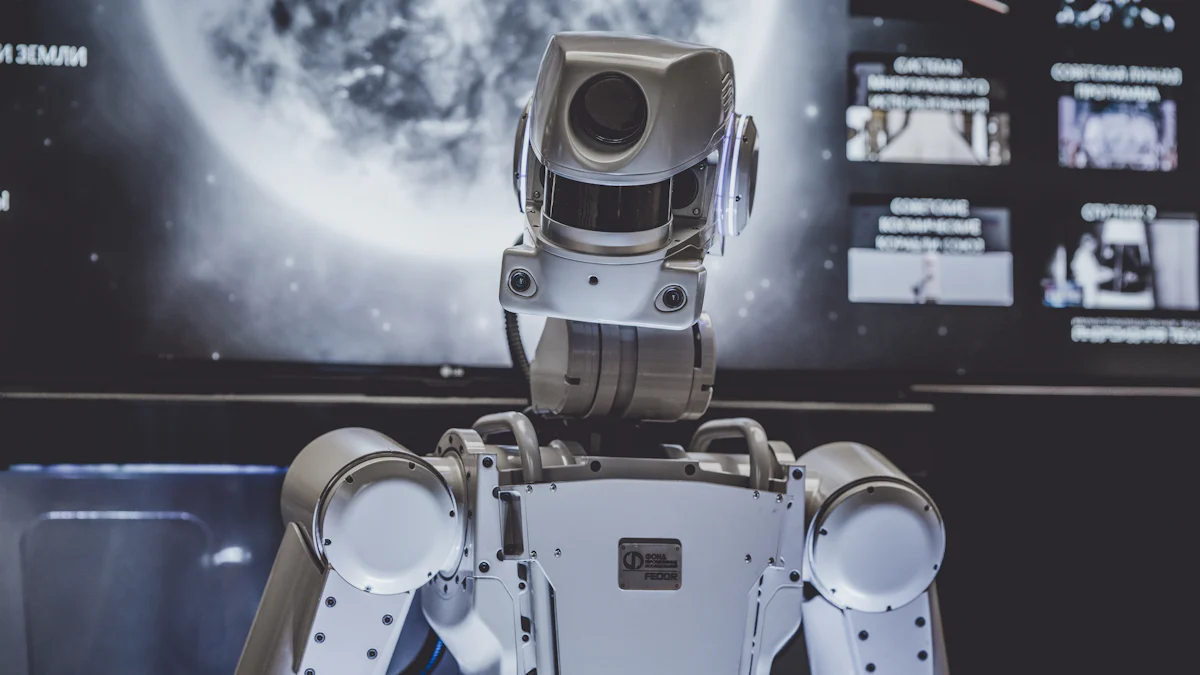The Future of Smart Logistics: Robotics and AI Transforming Supply Chains by 2030

The logistics and supply chain industry faces significant challenges, including inefficiencies and high operational costs. Technology drives transformative changes in this sector. Robotics and AI play pivotal roles in revolutionizing logistics operations. These advancements promise to enhance efficiency, accuracy, and cost-effectiveness. By 2030, the integration of these technologies will lead to a new era of Smart Logistics, optimizing every aspect of supply chain management.
The Current State of Smart Logistics and Supply Chains
Traditional Logistics Challenges
Inefficiencies and Delays
Traditional logistics systems often face inefficiencies and delays. Manual processes dominate many operations, leading to slower response times. Human error contributes to inaccuracies in inventory management and order fulfillment. These inefficiencies result in longer lead times and reduced customer satisfaction.
High Operational Costs
High operational costs present another significant challenge. Labor-intensive tasks require substantial human resources. Manual tracking and limited automation increase expenses. Traditional warehouses lack the scalability needed to handle fluctuating demand efficiently. These factors contribute to higher overall costs in the supply chain.
The Need for Technological Advancements
Increasing Demand for Speed and Accuracy
The modern market demands speed and accuracy. Consumers expect faster delivery times and real-time tracking. Businesses must meet these expectations to remain competitive. Advanced technologies like robotics and AI offer solutions. Automation can streamline processes and reduce errors. AI-driven systems enhance decision-making capabilities, improving overall efficiency.
Globalization and Complexity
Globalization adds complexity to supply chains. Companies source materials from various regions, increasing logistical challenges. Managing a global network requires advanced coordination and communication. Traditional methods struggle to keep pace with this complexity. Smart Logistics systems leverage data analytics and automation to manage these intricate networks effectively. These technologies enable better scalability and adaptability in a globalized market.
The Role of Robotics in Smart Logistics

Types of Robotics in Use
Automated Guided Vehicles (AGVs)
Automated Guided Vehicles (AGVs) play a crucial role in modern warehouses. AGVs streamline tasks such as picking, packing, and sorting. These vehicles navigate warehouse floors autonomously, reducing the need for human intervention. AI-powered systems enable AGVs to adapt dynamically to changes in demand. This optimization improves operational efficiency and reduces processing time.
Drones and Unmanned Aerial Vehicles (UAVs)
Drones and Unmanned Aerial Vehicles (UAVs) offer significant advantages in logistics. UAVs provide aerial surveillance and inventory management capabilities. These devices can quickly scan large warehouse areas, ensuring accurate stock levels. Drones also facilitate last-mile delivery, reaching remote or congested areas with ease. The integration of UAVs enhances overall supply chain efficiency.
Applications of Robotics
Warehouse Automation
Warehouse automation leverages robotics to transform traditional storage facilities into efficient distribution centers. AI-powered robots handle repetitive tasks like sorting, picking, and packing. These robots use sensors and cameras for real-time tracking and monitoring of inventory. This technology minimizes human errors and speeds up the order fulfillment process. Companies investing in warehouse automation see significant improvements in operational efficiency.
Last-Mile Delivery
Last-mile delivery represents one of the most challenging aspects of logistics. Robotics offers innovative solutions to address these challenges. Autonomous vehicles and drones ensure timely and accurate deliveries. These technologies reduce labor costs and minimize the risk of accidents. The use of AI-driven systems in last-mile delivery enhances customer satisfaction by providing reliable and efficient service.
Robotics continues to revolutionize the logistics industry. The integration of AGVs, UAVs, and other robotic systems optimizes various aspects of supply chain management. Businesses adopting these technologies experience increased efficiency, reduced costs, and improved accuracy. The future of smart logistics relies heavily on the advancements in robotics.
The Impact of AI on Smart Logistics and Supply Chains
AI-Driven Decision Making
Predictive Analytics
AI-powered systems enhance predictive analytics in logistics. These systems analyze vast amounts of historical data and external factors. This analysis helps anticipate demand patterns and inventory fluctuations. Companies can optimize inventory levels and streamline supply chain operations. Forbes highlights that AI ensures errors remain below 1%, improving overall accuracy.
Demand Forecasting
Demand forecasting benefits significantly from AI. Machine learning algorithms analyze historical data and market trends. These algorithms predict future demand with high precision. Accurate demand forecasting reduces stockouts and overstock situations. This leads to better inventory management and cost reduction. Optimal asset management and proactive capacity purchasing become achievable.
Enhancing Efficiency with AI
Route Optimization
Route optimization sees substantial improvements through AI. AI-driven systems analyze traffic patterns and weather conditions. These systems determine the most efficient routes for delivery. This reduces fuel consumption and delivery times. Enhanced route planning improves overall operational efficiency. Companies experience lower transportation costs and increased customer satisfaction.
Inventory Management
Inventory management becomes more efficient with AI integration. AI analyzes historical data and market trends to forecast inventory needs. This minimizes overstocking and inventory shortages. Real-time inventory tracking allows for dynamic adjustments. Companies can maintain optimal stock levels and reduce holding costs. Improved inventory management leads to better service levels and profitability.
Key Takeaways:
AI-driven predictive analytics and demand forecasting optimize supply chain operations.
Route optimization through AI reduces transportation costs and improves delivery times.
AI enhances inventory management by minimizing overstocking and shortages.
Integration of Robotics and AI in Smart Logistics

Synergistic Benefits
Improved Accuracy and Speed
Robotics and AI integration in Smart Logistics significantly enhances accuracy and speed. Automated Guided Vehicles (AGVs) and drones perform tasks with precision, reducing human error. AI algorithms analyze vast datasets to optimize operations. This results in faster decision-making processes. Companies experience shorter lead times and higher customer satisfaction. The use of AI-driven systems ensures real-time monitoring and adjustments. This leads to more efficient supply chain management.
Cost Reduction
The integration of robotics and AI contributes to substantial cost reductions in Smart Logistics. Automated systems reduce the need for manual labor. This lowers operational expenses. AI-powered predictive analytics optimize inventory levels. This minimizes overstocking and stockouts. Companies save on storage and holding costs. Route optimization through AI reduces fuel consumption and transportation expenses. Overall, businesses achieve significant cost savings while maintaining high efficiency.
Case Studies and Real-World Examples
Leading Companies Adopting These Technologies
Melton Logistics utilizes AI in logistics for automated warehousing. Robotics-powered solutions have transformed traditional warehouse spaces. These innovations have reduced errors and improved human safety. The company has seen a significant increase in productivity. The use of AI and robotics has made work safer and saved valuable time.
Amazon employs a fleet of AGVs in its fulfillment centers. These robots handle picking, packing, and sorting tasks. This has resulted in faster order processing and reduced labor costs. Amazon's use of drones for last-mile delivery showcases the potential of UAVs in logistics. The company has achieved remarkable improvements in delivery speed and accuracy.
Success Stories and Outcomes
Zunshida collaborates with domestic universities on AI inventory management technology. This partnership has led to dynamic management of inventory in transit. Real-time replenishment and shipping suggestions have optimized supply chain operations. The company has reported enhanced operational efficiency and reduced risks associated with inventory shortages.
JUSDA integrates the JusAI Intelligent Dialogue Engine into logistics operations. This AI-powered system revolutionizes customer interaction. Users access services through a single window and perform one-click Q&A. The chatbot interface enhances service efficiency and customer experience. JUSDA's implementation of AI showcases the transformative potential of these technologies in Smart Logistics.
Challenges and Considerations in Smart Logistics
Technological Barriers
High Initial Investment
Implementing advanced technologies like robotics and AI requires significant capital. Companies must invest in hardware, software, and infrastructure. The cost of acquiring and maintaining these systems can be prohibitive for smaller businesses. Large enterprises may find it easier to allocate resources for such investments. However, the return on investment (ROI) can justify the initial expenditure over time.
Integration Complexity
Integrating robotics and AI into existing logistics systems presents challenges. Compatibility issues between new and old technologies can arise. Companies need to ensure seamless communication between different systems. This requires specialized knowledge and expertise. Training employees to operate and maintain these advanced systems adds another layer of complexity. Successful integration demands careful planning and execution.
Ethical and Social Implications
Job Displacement Concerns
Automation and AI raise concerns about job displacement. Many fear that robots and AI will replace human workers. This concern is particularly relevant in labor-intensive industries like logistics. While automation can increase efficiency, it may lead to job losses. Companies must address these concerns by investing in retraining programs. Providing opportunities for workers to acquire new skills can mitigate the impact of job displacement.
Data Privacy and Security
The use of AI and robotics in logistics involves handling vast amounts of data. Ensuring data privacy and security becomes paramount. Companies must protect sensitive information from cyber threats. Implementing robust cybersecurity measures is essential. Compliance with data protection regulations is also necessary. Failure to secure data can lead to significant financial and reputational damage.
Key Takeaways:
High initial investment and integration complexity are major technological barriers.
Job displacement and data privacy are critical ethical and social considerations.
Companies must balance technological advancement with moral responsibility.
Future Outlook and Predictions for Smart Logistics
Emerging Trends
Collaborative Robots (Cobots)
Collaborative robots, or cobots, will play a significant role in Smart Logistics by 2030. Cobots work alongside human workers to enhance productivity. These robots handle repetitive tasks, allowing human workers to focus on more complex activities. Cobots improve workplace safety by taking over hazardous tasks. Companies investing in cobots see increased efficiency and reduced operational costs. The integration of cobots into supply chains will revolutionize warehouse operations.
AI-Driven Autonomous Vehicles
AI-driven autonomous vehicles will transform logistics and supply chains. These vehicles navigate without human intervention, optimizing delivery routes. Autonomous trucks and delivery vans reduce fuel consumption and emissions. AI systems analyze traffic patterns and weather conditions to select the most efficient routes. Companies adopting autonomous vehicles experience faster delivery times and lower transportation costs. The widespread use of AI-driven vehicles will redefine last-mile delivery.
Long-Term Benefits
Sustainable Supply Chains
Sustainable supply chains will become a priority by 2030. Smart Logistics technologies contribute to sustainability by reducing waste and energy consumption. AI optimizes inventory management, minimizing overstock and reducing waste. Autonomous vehicles lower carbon emissions through efficient route planning. Robotics streamline warehouse operations, reducing energy usage. Companies focusing on sustainability gain a competitive edge and meet regulatory requirements.
Enhanced Customer Experience
Enhanced customer experience will be a key benefit of Smart Logistics. AI-driven systems provide real-time tracking and updates, improving transparency. Predictive analytics ensure accurate demand forecasting, reducing stockouts. Robotics and autonomous vehicles enable faster and more reliable deliveries. Companies leveraging these technologies offer superior service levels. Customers enjoy timely deliveries and better communication, leading to higher satisfaction.
Robotics and AI hold transformative potential for logistics. These technologies enhance operational accuracy and efficiency. AI-driven systems optimize data through natural language processing and machine learning. Robotics improve working conditions and reduce costs. Early adopters of AI in logistics have achieved remarkable improvements. Businesses must embrace these advancements to remain competitive. Staying informed and adapting to upcoming changes will ensure future success.
See Also
Revealing Tomorrow's Supply Chain: AI Fusion Perspectives
Artificial Intelligence in Logistics: Transforming Future Supply Chains
Investigating Sustainable Robotics Trends in Supply Chain Operations
Delving into Robotics Tech: Evolution of Supply Chain
Automated Future: Advantages of High-Tech Manufacturing Warehouses
